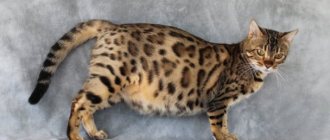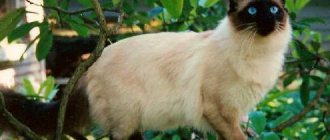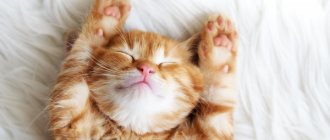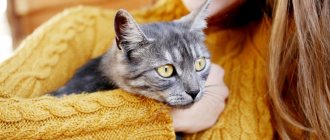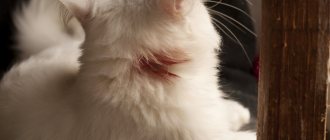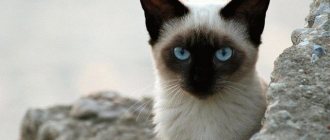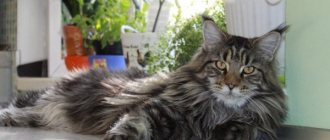Most cat breeds, and more than 70 of them are registered, occurred as a result of random mutations or natural selection in a certain area, but some were bred by purposefully crossing wild cats with domestic relatives. Such breeds are called hybrid. One of the most prominent representatives appeared quite recently, called caracat.
History of the origin of the breed
The first representative of the hybrid breed Caracat appeared as a result of an accidental love affair between an ordinary Murka and a Caracal, a wild inhabitant of the steppes. This meeting took place at the Moscow Zoo in the 90s of the 20th century. Two months later, a charming little boy with tufts on his ears was born. The general public very soon learned about the precedent, but no one began to breed a new breed.
Caraquetas inherited their exotic appearance from their caracal father.
The story continued in the first decade of the 21st century in the United States. Joy Geisinger achieved the greatest success by crossing a male caracal with a domestic Abyssinian cat. The breeder’s efforts were appreciated by the international felinological organization TICA, but after her death, breeding work was suspended.
A little later, scientific research was resumed in Russia: Irina Nazarova, a felinologist and owner of the Krasnodar nursery KATALEYA, began closely breeding caraquets and in 2021 received the third generation of kittens.
Today the breed is recognized only by the International Cat Union (ICU). However, breeding work is still ongoing, because the infertility of male hybrids up to the fourth generation remains a significant and unresolved problem.
Sometimes you can find information on the Internet that TICA (International Cat Association) recognizes Caraquets as an experimental breed, but there is no such information on the official website of the felinological organization.
External components
The animals have characteristic features for wild cats - high and large paws, a muscular body, small layers of fat formed on the abdomen. They have round, large eyes with dark markings at the corners. Large and ears with a tassel at the end. The length of the cat is 90 cm, height 50 cm, but the weight reaches 15 kilograms.
Against the background of the brown color of the Caraquet breed, noticeable stripes can be traced on the paws, tail, spots on the stomach or chest.
Appearance of caraquet
According to the international ICU standard, a caraquet must have:
- strong, flexible and muscular body, reaching 1 meter from nose to tip of tail;
- weighing from 10 to 15 kg and height up to 50 cm at the withers;
- high, strong and proportional paws with dark pads;
- tail of medium length, wide at the base and gradually tapering to a rounded tip with darkening;
- fat fold in the groin;
- long and strong neck;
- a wedge-shaped head with smooth transitions;
- convex forehead;
- a wide chin without protrusions or bevels;
- large, pointed, high-set ears, covered on the outside with short black hair, decorated with white brushes on the inside, and tassels at the tips;
- a wide and convex nose of a dark color (a pink middle is also acceptable);
- large amber or green almond-shaped eyes, outlined with a dark line against the background of light “glasses”;
- dark marks above the eyebrows, on the cheekbones, whisker pads and black “tears” coming from the inner corners of the eyes;
- short, thick and soft wool of medium length with ticking - lighter at the base and darker at the tips;
The belly, chest and inner side of the paws of the Caraquet are lighter in color with spots; white hair should only be around the eyes and on the chin
- one of four types of color: wild - with black marks on a red-brown background;
- chocolate - with brown spots;
- cinnamon - red-brown markings on a peach background;
- silver - reminiscent of the color of a snow leopard.
The most striking resemblance to the caracal is found in the first generation (F1). They inherit 50% of their father's genes. Subsequent individuals increasingly take on their mother's traits and even decrease in size, but the color of their fur and the tufts on their ears remain their unchanged attributes.
Features of breeding
Since cats in the first generation are infertile, you should not expect offspring from two representatives. Breeders cross domestic cats with wild caracals.
Only with 5 offspring can you count on the appearance of fertile cats. In the meantime, Caraquet cats can be crossed with cats of other species. Due to this, the breed is recognized as experimental until the birth of babies from two caraquets.
Today, kittens of the fifth generation have already appeared. The offspring of the caracal and the Abyssinian still remain more popular. When the caraquet is produced consistently, the cost will decrease.
True connoisseurs of exotics have already acquired such pets and cannot get enough of their attractive features and gentle character. You can also appreciate the beauty of the caraquet from photographs presented on the Internet.
Character of the caraquet
Despite the wild blood flowing in their veins, Caraquets have a fairly flexible, balanced and affectionate disposition, although they are not without some independence. They are very inquisitive, energetic, love outdoor games, exhibit a pronounced hunting instinct, prefer to be nocturnal, but can adapt to the regime of family members.
Caraquetas do not like loneliness - they need company, but they tolerate changes of environment - car rides, walks in nature, moving - easily. The exotic pet will have the warmest relationship with its owner. Like a devoted dog, he will accompany him everywhere and participate in household chores. The caracat shows its love by massaging its owner with its paws, licking him, butting him, and “chirping” in response.
Caraquet kittens adopt behavior and communication skills from their mother, a domestic cat.
For small children, such an animal is not at all dangerous; it has no tendency to aggression. However, if you test his patience too persistently, then, like any cat, he is capable of using his claws. The caraquet perceives strangers warily, and may even hiss, defending its possessions.
Domestic “lynxes” are distinguished by a sharp mind, are easy to train - they love to carry various objects in their teeth, easily remember their nickname and respond to it. In everyday life, with proper upbringing, there will be no problems with this cat: she will not do dirty tricks or destroy property and will quickly understand what a tray and scratching post are for.
[edit] Character
According to breeders and owners of the Caraquet, this hybrid cat is distinguished by an affectionate and friendly disposition, special devotion to its owner, and curiosity. They have a lively temperament and a consistently balanced emotional state. They are involved in the life of the owner, happy to accompany him in any household (and not only) affairs. Responsive and capable of training, various games that are more typical for dogs (for example, fetching a thrown ball). Unlike the caracal, according to the owners, it is not prone to damaging furniture and other property in the house, and therefore does not require keeping in an enclosure. Organized and neat in his cat's life: he strictly follows the rules of the toilet and, with proper upbringing by the owner, does not violate other rules of conduct in the house (especially those related to food).
Health
Due to the youth of the breed, it is too early to talk about any genetic diseases inherent in it. It is believed that caraquets inherited excellent immunity and excellent health from their wild father. Over 10 years of working on the breed, not a single case of infectious infection of caraquets has been identified, but it is better to play it safe and annually give your pet the necessary vaccinations against:
- panleukopenia;
- rhinotracheitis;
- calcivirosis;
- chlamydia;
- rabies;
- depriving.
Once every three months and before vaccination, it is necessary to carry out deworming, selecting the dose of the drug depending on the weight of the animal
It is unknown how long the life of a caracat is, but their father, the caracal, lives on average up to 18 years at home.
How much does a caraquet kitten cost?
The unique breed is not only the rarest, but the most expensive in the world. A kitten without the right to breed costs about 1,000,000 rubles. To find out more about prices, it is better to contact the breeders directly. One of the requirements when purchasing a caraquet is to maintain further communication, in exchange for which the nursery provides competent advice and assistance in growing.
Every year the breed becomes more and more numerous, and the price of a caraquet kitten is more affordable, this cannot but please exotic lovers and potential buyers.
Optimal living conditions for caraquets
Despite their wild roots, caraquets can be kept in a city apartment. However, a large, active, jumping cat (up to a height of three meters) needs space, so a country house would be an ideal option for such a pet. The caracat will be grateful to the owners if they:
- they will provide him with toys - traditional mice, teasers, squeakers, as well as rubber balls, rings and dumbbells for dogs are suitable for this;
The most important criterion when choosing a toy is safety: you should avoid fragile materials, small parts and feathers that a caracat can swallow
- they will build a sustainable sports complex with tunnels, slides, and multi-level playgrounds;
- organize a “nest” for relaxation on a hill;
- place a spacious tray in a secluded place, away from the sleeping area and bowls of food;
It is preferable to choose wood or paper litter for the toilet - it will not harm the pet, even if it decides to taste it.
- Walking in the fresh air will be allowed.
If your pet regularly goes outside, then treatment for ticks and fleas will not hurt - special collars, sprays and drops on the withers will help.
It is necessary to walk a caraquet even in the local area on a harness, otherwise it may get too playful, jump over the fence and run away
Having brought a small caracat into the house, limit the geography of its movements to one room. Place a bowl, tray, bed and toys within walking distance, play with the kitten more, do not make sudden movements or make noise - all this will help him adapt faster to the new place.
Within a week, the kitten will fully adapt to its new family.
Care and maintenance
If we talk about caring for the external appearance of an exotic pet, it is not difficult due to the peculiarities of the structure of the body and coat. Certain manipulations are still necessary:
- Firstly, you should brush your pet’s hair at least once a week with soft massage wool. This will help get rid of excess hair and, if you teach your baby to do this from an early age, it will bring pleasure to both the cat and the owner. During periods of seasonal shedding, you need to comb your pet more often. The animal's coat, although short, has a fairly thick undercoat. At the end of combing, it is better to run wet hands over the animal’s body several times to make the fur coat sparkle and shine, in addition, the fallen hairs will be removed.
- Caraquetas do not need bathing, but if the pet loves water treatments, a full wash with shampoo and other care products is still not recommended more than once every three months, so as not to damage the natural protection of the coat.
- This breed does not need hair trimming or other grooming at all.
- Trim nails, especially if there are small children in the house, preferably once or twice a month. To do this, you should choose a special nail clipper made of high-quality material.
- Each time you brush, it is advisable to carefully inspect your pet’s ears and, if necessary, carefully clean them of wax deposits with special cotton swabs and pads. It is recommended to use veterinary lotions. Read how to clean your cat's ears.
- The eyes should also be checked periodically. This breed is not prone to the appearance of tear secretions, but if there are any signs of trouble, you should immediately wash them with a chamomile solution, an infusion of strong black tea, special lotions and immediately contact a veterinarian.
- The bed, house, toys, bowls for food and water, the front door and house rugs should be thoroughly washed (cleaned) at least once a week and treated with disinfectants and against fleas.
- If a cat is taken for a walk every day, then after it it is necessary to wash or wipe its paws with a damp cloth, or use special wipes for animals for these purposes.
In matters of education, Caraquetas are also fertile pets. They are smart, obedient, easy to train and instill good manners. These animals do not damage furniture and walls, do not steal food from the table, are not capable of dirty tricks on the sly, and easily understand what is required of them when introduced at an early age to a litter box, scratching post, and harness.
It is best to use wood chip pallets as filler for two to three month old Caracats; they are environmentally friendly and cannot harm the baby’s health, even if the granules are swallowed. At an older age, you can switch your pets to a material for the tray that is more suitable for the owner and household members, for example, silica gel.
In principle, this is not particularly necessary, since these cats are very clean. If you change the litter and wash the toilet daily, there will be no garbage or smell.
After moving a Caraquet kitten to a new home from its native nursery, it is better to initially allocate a separate room for the baby, where to place a litter tray, scratching post, house and food bowls close to each other. It is also worth giving the cub several toys so that adaptation to the new place of residence is less painful and faster.
During this period, you need to devote as much time as possible to the kitten, play and talk with it often, and try to hold the baby in your arms more often. Under no circumstances is it recommended to raise your voice, much less beat an animal, both at a young and an older age. These cats are extremely intelligent and will quickly understand what is required of them even without extreme measures.
At first, the baby, in response to the movements and even the caress of the owner, can hiss intimidatingly, quite loudly and frighteningly. You should not pay attention to this; as soon as the kitten stops being afraid, this problem will disappear by itself. During this period, you should try to protect your pet from loud sounds, noise, and sudden movements.
It is advisable to quickly instill in your kitten the habit of wearing a harness on walks, walking and running with him on a leash. The animal really needs sufficient physical activity, because it is a close descendant of a wild predator and its health directly depends on its physical form. If there is such an opportunity, then it is advisable to purchase a special multi-level cat complex for your pet, buy safe toys for active games - flyers with feathers, rubber balls, soft objects. Animals should not be taught to play with a person's open hands and feet, so as not to provoke the consolidation of bad habits and to avoid subsequent scratches on household members.
If the family lives in a private house, then for Caraket you can build a special large summer enclosure with a multi-level complex and a small pond - here the pet can play and relax alone in the warm season. Walking in open spaces should only be done with a harness and leash. After all, Caraket has excellent physical shape and, when playing, he can easily jump over the fence, run away and get lost.
The most important thing this pet needs is the love and attention of its owner. With mutual affection and respect, there will be no problems with maintenance.
A particularly pleasant aspect of keeping a Caraquet at home is that this breed is considered hypoallergenic. Of course, this cannot be stated with 100% certainty, but the animal really does not have its own odor and is distinguished by a low content of a special protein in its blood, which usually causes irritable reactions in people. Read about hypoallergenic cat breeds.
Nutrition
It is better to feed caracats with natural food. The diet should include:
- raw meat: quail;
- chicken;
- rabbit;
- beef
It is forbidden to treat carakets with pork, thermally processed foods, smoked meats, sweets and any other food from the master's table. Despite a naturally strong digestive system adapted for digesting skins and bones, improper nutrition can seriously undermine the health of a pet.
Kittens are fed minced meat heated to room temperature, giving it three times a day. From five months onwards, the diet of small predators includes meat cut into pieces. By this age, a young caracat is able to “persuad” three quails a day. Adult animals are fed 1–2 times a day, removing the leftovers after meals. The required daily amount of food is 5–10% of the pet’s body weight.
Video: a three-month-old caracat eats raw meat
Adult caraquets can be switched to industrial grain-free super-premium and holistic food:
- Acana (Canada);
- Carnilove (Czech Republic);
- Go Natural (Canada);
- Grandorf (Belgium, France);
- Farmina N&D (Italy, Serbia).
In the wild, in search of a source of water, caracals may not drink for 3–5 days, and they do not always manage to eat. The fat fold on the abdomen helps to survive a forced hunger strike - it stores reserves of nutrients. Caraquetas also have such a reserve, but when switching to dry food, make sure that clean water is always freely available.
Grooming
In terms of care, the Caracat is no different from an ordinary short-haired cat.
Hypoallergenic and odorless wool is considered a pleasant bonus. However, this statement is very controversial, especially considering that allergies are caused by a special protein contained in the saliva, secretions and particles of animal skin.
Grooming
It is not difficult to maintain a presentable appearance of a caraquet fur coat:
- once a week to remove dead hairs, it is recommended to comb your pet with a rubber mitten, and in the summer - during the molting period - the procedure should be carried out daily;
- The cat should be bathed once every three months or as needed - the procedure will not cause problems, because caraquets love water very much and turn it into an object of play, but make sure that the water does not get into the ears; The following shampoos are suitable for short-haired cats: VEDA “Phytoelite”;
- Doctor ZOO;
- "BioVax";
- Ms. Kiss "Graceful Panther";
- Cliny “Nutrition and Shine”;
- AVZ Elite Professional;
- Rolf Club Keratin+ Shiny;
- Iv San Bernard Traditional Line.
Photo gallery: caraqueta coat care products
VEDA “Phytoelite” shampoo is created on the basis of a decoction of nettle leaves. “Doctor ZOO” shampoo with keratin and provitamin B5 improves metabolic processes in the skin. “BioVax” shampoo contains natural ingredients - extracts of rose hips, St. John’s wort and tea tree oil. Shampoo-conditioner Ms. Kiss “Graceful Panther” effectively nourishes and soothes the skin, strengthens hair follicles and restores the structure of hairs Cliny shampoo-conditioner “Nutrition and Shine” contains mink and grape seed oil, therefore it nourishes, restores hair and gives it shine Thanks to natural ingredients, AVZ Elite Professional shampoo effectively restores hair structure Rolf Club Keratin+ Shiny Shampoo contains a keratin complex that will give the coat elasticity, shine and volume Iv San Bernard Traditional Line Shampoo for dogs and cats with lemon aroma moisturizes the skin and prevents the formation of dandruff
Nail care
The caraquet must be provided with a durable scratching post, for example, made from sisal, a coarse natural fiber that is durable and harmless. With flimsy corrugated cardboard devices, large and strong cats will be dealt with quickly. In addition to this, once every two weeks it is necessary to shorten your pet’s claws, for example, using a nail clipper-secateurs that has a protective stop.
Claws should be cut at an angle of 45°, 2 mm away from the pulp, which is rich in blood vessels.
Some owners declaw cats, but this is inhumane and is equivalent to amputating the upper phalanges of a person's fingers along with their nails. In fact, the animal will become disabled: it will not be able to hunt, climb to heights, jump, maintain balance, it will become clumsy and defenseless, which will negatively affect its psychological state.
The caraquet's claws are retractable, and with proper training the animal will not damage furniture or scratch itself during games.
Many owners purchase anti-scratch guards for their pets - a newfangled accessory that allows them to protect furniture and hands from damage. The material of the caps and the medical glue with which they are attached are completely safe for the animal, but not everything is so rosy:
- anti-scratch pads can cause discomfort - the cat will not be able to catch its claws if it decides to climb to a height, and this is dangerous;
- the pet’s gait may change, because the claws will constantly remain extended;
- Deformation of the claws and the occurrence of inflammatory processes cannot be ruled out.
Ear cleaning
A caracat's ears should be examined once every six months. The process will not take much time:
- you need to play with the animal or calm it down with stroking;
- fix it and turn the ear out;
- swipe with a dry cotton pad, removing dry dust - movements are made outward;
- repeat the procedure with a clean cotton swab dipped in warm boiled water.
You cannot clean the ear canals with cotton swabs - you can damage the eardrum. If there is discharge, plaque, or an unpleasant odor, you should contact a veterinarian.
Eye cleaning
You need to wipe the eyelids of a caracat with a soft cloth soaked in strong tea leaves, chamomile infusion or warm boiled water. Movements are carried out from the outer corner of the closed eye to the inner. Excess liquid is blotted with a dry cloth.
You should not touch the animal's eyeball - the delicate cornea is easily damaged. The presence of purulent discharge should alert you and be a reason to contact a veterinary clinic.
Dental care
Caraquetas that eat raw meat or dry food do not need to brush their teeth. They do not have time to form tartar due to natural cleansing and massage of the gums.
Care
- Wool
Wool does not require special care. During shedding, it is recommended to comb your pet daily with a rubber massage mitten or a comb for short hair. At other times, the procedure can be performed 1-2 times a week.
Caraqueta cats are not afraid of water; on the contrary, they love water procedures and turn them into games. Bathing should be done once every 3 months.
- Ears
It is advisable to wipe the animal’s ears once every two weeks. First, remove dust and dirt with a dry cotton pad, and then soak the clean pad in warm water and wipe your ears again. Remember that you should not clean your ears with a cotton swab, as this can damage your ear canals and eardrum.
- Claws
The pet will need to purchase a durable scratching post, and also shorten its claws 2-3 times a month using a nail clipper. With proper upbringing, a cat will not scratch or damage furniture.
- Eyes
Dark plaque in the corners of the eyes should be regularly cleaned with a cotton pad soaked in a decoction of herbs or tea. If there is purulent discharge or tearing, contact your veterinarian.
Subscribe to the newsletter and get a discount at the pet store “Lubimchik”
Thanks for subscribing!
Features of mating and breeding of the caraquet
The main difficulty in breeding caraquets is the sexual impotence of males until the fourth generation. Only females take part in procreation. Males of other breeds are selected as partners for them:
- Abyssinians;
- orientals;
- Ocicats;
- Serengeti;
- Egyptian Mau.
It is optimal to breed caracats at the age of one and a half years and on the 3rd–6th day of estrus. Both partners must:
- look healthy and well-groomed;
- have the necessary documents - veterinary passport, pedigree, club card, evaluation sheets from exhibitions;
- undergo a veterinary examination;
- be vaccinated no more than a year and no less than one month ago;
- undergo parasite treatment a week before the expected event;
- have a fresh manicure so that in the heat of passion you don’t injure each other.
Before mating, a contract is drawn up, which specifies all the conditions, information about the producers, their owners and the date of the event. The “wedding” is held on the groom’s premises, and in order for the bride’s adaptation to go smoothly, you need to take her personal belongings (bowl, tray, bed) with you. The cat spends several days in the new place - as soon as the partner does his job, he will lose interest in her, because the female will lose her characteristic smell. Pregnancy will last from 65 to 79 days, and there will be 1-2 kittens in the litter.
Without harming its health, a cat can give birth once a year - it needs time to recover
An amateur should not breed an experimental caraquet breed - the help of a specialist from the nursery where the animal was purchased is required.
Breeding
Caraquets are among the rarest cat breeds. This is due to the fact that when several species of felines are crossed, the offspring are often born infertile. In case of a successful mating, 1-2 kittens are born, while the boys are always infertile. However, this is not the only problem for future offspring; the fact is that the mother cat is smaller in size than the caracal father, so it is difficult to bear and give birth to such kittens.
Due to difficulties in breeding, the cost of kittens is high, ranging from US$15,000 to US$25,000. Every year the population of caraquets increases, which means the price will decrease over time.
Watch also the video on the topic:
Castration of caraquets
If your plans do not include getting offspring, your pet needs to be castrated or sterilized, otherwise it will mark its territory, behave nervously, and may become seriously ill in the future. As a rule, the operation is well tolerated, and after a week the animal forgets about what happened. The right time for genital removal surgery is 8–11 months. The process of preparation and rehabilitation proceeds as follows:
- 30 days before surgery (no more than a year), the animal must be vaccinated, and two weeks - treated for parasites;
- within twelve hours before surgery, a fasted diet and plenty of fluids are required;
- immediately after the operation, you need to provide the pet with peace by laying it on a bedding located on the floor;
- it is important to put an Elizabethan collar or blanket on it (for 10 days) so that there is no threat of infection of the seams as a result of licking;
- you need to regularly treat the wound with Chlorhexidine and give painkillers (only on the recommendation of a veterinarian);
- In the first days, you should not put a strain on the caracat’s digestive tract, so it is better to give raw meat in the form of minced meat.
Young individuals purchased from a nursery not for breeding will already be neutered by the breeder.
Sky-high cost
The Caraquet breed is rare and expensive. You can purchase a kitten without the right to breed for no less than 1 million rubles. In Europe and America from $12,000. Breeders can advise you on prices in more detail. However, they reserve the right to maintain communications.
The nursery provides advice on nutrition, care, and rearing of caraquets. Every year there are more and more kittens, which allows prices to be reduced to the delight of exotic lovers. Keeping such a pet will not be at all easy, because you will have to spend at least 300 rubles a day on the caracat’s diet alone.
This exorbitant cost is explained by the rarity of cats that can be purchased in catteries in the USA and Russia.
An important factor is the breeding characteristics, because the offspring of caraquets is insignificant - no more than two kittens, which, moreover, must meet the requirements of international cat associations.
Choosing a kitten and its cost
You should only purchase a purebred kitten from a trusted breeder. Here are the signs of a reliable nursery:
- it is registered in a large international felinological system;
- the breeder has a veterinary education or a certificate of completion of felinological courses;
- the nursery is a member of a club that can recommend it;
- it has its own website that provides contact information, as well as information about breeding animals, pedigrees, titles, expert ratings from exhibitions, etc.;
- has a good reputation and mostly positive reviews on forums and review sites;
- located in a spacious and clean house, equipped with everything necessary for a comfortable stay for animals: trays, scratching posts, beds, high-quality and fresh food, and a sufficient amount of clean water.
When the issue of choosing a nursery has been resolved, it’s time to think about purchasing an exotic friend:
- the kitten must be at least three months old - until this time it needs a cat mother: she feeds it with breast milk, thereby building the baby’s immunity;
Half-centimeter tassels on the ears of small caracats will appear by the month of life.
- teaches everything she knows: to wash herself, go to the litter box, overcome obstacles, hunt (at least her own tail);
- with clean eyes, ears and nose, without discharge or unpleasant odor;
- veterinary certificate and passport with deworming and vaccination marks;
The Caraquet is a difficult breed to breed, which explains its fabulous price - from 500 thousand rubles. up to 3 million rubles depending on the pedigree and generation of the hybrid. Currently, work on it is carried out in the following nurseries:
- KATALEYA (Krasnodar) and subsidiaries: VIVAT CARACAT (St. Petersburg);
- CARACAT ANGARA (Irkutsk);
- ALTAY-CARACAT (Barnaul).
Caraquets ®
- Caraquet – who is this?
- Is the Caraquet breed?
- History of the appearance of caracets
- About working on the program
- Caraquet F1 VIPLEO (75%)
- Caraquet F1 VIPLEO (50%)
- Caraquets F3 VIPLEO
- Caraquets F4 VIPLEO
- Feeding
- Sounds that caraquets make
- The F1 caraquet kids are sleeping sweetly...
- About education...
- Tray, toys, scratching posts...
Author: Kuzmina Anna Date: 01/08/2018
Caraquet – who is this?
At the moment (03/20/2018) there are only caracat hybrids of the first and second generations (Caracat F1 and F2). I’ll tell you in order what this means, since many questions arise on this topic.
First generation kittens (first generation) must have at least 50% wild blood from the feline species (for example, serval, caracal, jungle cat, ALC). In our case, the F1 caracat must have at least 50% caracal blood. To get an F1 Caracat, one of the parents must be a Caracal. In our VIPLEO® nursery, this role is played by the male. This means that our F1 Caracat kittens have a Caracal father, and the mother is an ordinary purebred cat, since F3 Caracat females and later generations do not yet exist. And they are also needed in the correct type, color and size (which is what breeders of F1 and F2 Caracat cats are currently working on). The role of mother at the moment can be any breed or a cross of breeds suitable in type, color, size. Often they use the Abyssinian breed or its cross with other breeds (since the Abyssinian in its “pure form” is a very small cat for a caracal), the Chausie and its cross, the Oriental and its cross, etc. Our nursery also uses these breeds and crosses of breeds.
Caracal and caracat of VIPLEO nursery
What does caraket F2 mean? This means that the kitten must have at least 25% wild ancestor blood. In the pedigree of F2 Caracats, the caracal is the grandfather on the mother's side. Due to the fact that fertile male caracats do not yet exist (the first generations of males in hybrids are usually sterile), a male suitable in type, color and size from other breeds or a cross between breeds is selected as the father for F2 caracat kittens. Now work is underway to obtain later generations of F3, and subsequently F4, F5, as well as to obtain fertile male caracats. As a result of this complex and painstaking work, it is very important not to lose the beauty, type, color, tassels, and also to preserve the maximum size from the caracal ancestor! Next, it will be possible to prepare for the recognition of the Caraquet breed and its removal from the category of experimental.
A frequently asked question is: is the Caraquet breed?
I decided to make a short video and voice it, since some questions are asked very often and it’s difficult for everyone to answer the same thing in PMs and comments. These are the first generation hybrids from the caracal - caracat F1. This means that their father is a caracal, and their mother is a purebred cat. In our case, in the video, the kittens’ mother’s breed is Chausie, and our father is a young and large male caracal, whose current weight is 22 kg, he is an affectionate and completely adequate cat. Mom is an extremely affectionate and friendly cat, her weight is around 4-4.5 kg. Also in our cattery cats of other breeds and mixed breeds the CARAKET program
Due to the difference in size and a number of other features, it is very difficult to get F1 Caracat kittens and many breeders fail. Therefore, at the moment, in the whole world there are only two breeders producing F1 Caracat kittens and we are very proud of this. They are truly the most unique and rare cats in the world. Unlike servals and caracals, which we do not recommend and do not sell for apartments, caracat kittens can be kept in an apartment, live with other cats and dogs, as well as in families with small children. In the following videos I will tell you a little about feeding, maintenance, toys, scratching posts, etc.
Today, work is underway on a program for breeding the experimental breed CARAKET . But there is no breed and there cannot yet be. Only the first generations of hybrids have been obtained (Caraket F1 and F2). The breed is still far away... First, you need to get fertile male Caracats, reach the fifth generation (Caracat F5) and still invest a lot of effort and labor so that it is recognized as a breed and taken out of the experimental category. Therefore, it is incorrect to assert that the breed already exists, and even more so to proclaim someone as the “creator of the breed” Caraquet... This misleads people, gives incorrect information and looks like a deception. Yes, this is a long but interesting path and I really hope that over the years it will be possible to develop the breed and it will be recognized. Then we will all admire the beautiful Caraquets as a breed, but at the moment only hybrids are born. And it doesn’t matter who exactly breeds the breed, it is important that it exists and they look great, and in appearance they are similar to the ancestor of the caracal.
History of the appearance of caracets
The history of the appearance of caracats supposedly, according to unknown facts, began in 1998, when in the Moscow Zoo (Russia) offspring were unexpectedly born from a caracal cat and a domestic cat of an unknown breed. According to unverified information, an ordinary cat entered the enclosure in which a male caracal was kept, and soon gave birth to a kitten with tufts on its ears and an unusual color, close to the color of a caracal.
The second fact of the birth of F1 caracets dates back to 2007. Then the American breeder, the first and only breeder in the world (as of the indicated date) Joy Geisinger , who later became the curator of the experimental Caracat breed at the international cat association TICA, invested a lot of effort and labor in its promotion.
It was she who carried out the planned crossing of a domestic Abyssinian cat and a Caracal cat, as a result of which the offspring of first generation kittens (Caracat F1) were obtained. Unfortunately, in 2008, Joy died of a sudden heart attack and work in this direction was suspended. Caracat F2 Date of birth: April, 2011 Breeder: Allison Navarro Owner: Teralee A. Harral Photo: September, 2018
Later, thanks to the work of another breeder Allison Navarro (pictured), it was possible to obtain first and second generation hybrids from the caracal - caracat F1 and F2 . Due to current life circumstances, further work on the development of the experimental caraquet breed and other savannah hybrids (which she also successfully worked on) Allison Navarro was suspended in 2015. The caracat kittens obtained as a result of this work still delight their owners.
In Russia in 2014, the first generation F1 hybrids were born. Then these wonderful kittens appeared in Ukraine.
At the moment, our VIPLEO® nursery is one of only two in the world that can produce these precious kittens. In addition, today there are several successful breeders in Russia working to produce F2 Caracats. Our nursery also works towards obtaining decent F2 caracats that are suitable in type, size and color.
We hope for successful continuation of work on the future breed by all Caraquet breeders and wish us all good luck!
About work on the program “Caraquet of our nursery VIPLEO®”
It turns out that we were the first in the world to receive CITES for Caracat F1 ! The first legal Caracat kittens with a full package of documents were born in our nursery! In addition, all Caracat kittens born in our VIPLEO® nursery have a state confirmation of the birth of first-generation hybrids from a caracal (caracal and domestic cat) and second generation (female first-generation hybrid from a caracal and a domestic cat)! All Caracat F1 and F2 are registered with TICA , and this is already more than 20 individuals. We manage to get very beautiful, large, pre-registered experimental breed standard Caraquet kittens. And more additions are expected soon!
Our VIPLEO® nursery officially operates under the Caraquet . The nursery is constantly working to obtain suitable females and males for the Caraquet program . This is very responsible and takes a lot of time, effort and patience. But at the same time, it is a very interesting and enjoyable job. Observing the results, you want to invest and develop even more. The results of our work are displayed in both TICA and CITES , since we are dealing with hybrids and, first of all, all our successes must be recorded officially, without breaking the law. Our Caracat kittens since 2015 have all state documents, acts, origins, official registrations. OUR CARAQUETS are the FIRST in the WORLD (!!!) cats that are registered in the international organization CITES . These are the first legal Caracat kittens in the world! We, starting in 2021, regularly receive CITES for our Caracat kittens.
CITES Certificates
We are intensively working on the “Karaket” program: publications in magazines, on Internet resources, at exhibitions and television programs, and there is still a lot of interesting work ahead. A lot of work has already been done in the nursery to breed suitable males for producing F3 and F4 caracat . Thanks to this work, excellent caraquets F3 and F4 . There are many developments and plans for the future. We will inform you about the work of our nursery under the “Experimental Caraquet Breed” program.
F1 caraquets from VIPLEO kennel. Article “The first F1 caracats VIPLEO (75% caracal blood)”
Our VIPLEO graduate Nessie, F1 caracat (75% caracal blood). Age - 1 year.
Our graduate is VIPLEO Baby, F1 caraquet (75% caracal blood). Age - 1.3 years, weight - 15.9 kg.
Fortunella - caracet F1 VIPLEO (75% caracal blood)
Caracquet kitten F1 from VIPLEO cattery (75% caracal blood)
Caracats F1 from VIPLEO nursery (50% caracal blood)
Caraquets F3 VIPLEO
In the video and photo you see girls of the second litter of F3 Caracats from VIPLEO®, born in the spring of 2021 (the first F3 litter in our nursery was born back in 2021).
The kittens perfectly retained all the characteristics of their caracal ancestor. Although it was very difficult to obtain kittens with such striking qualities in later generations. They are all good size and ticked. In addition, like the ancestor of the caracal, F3 kittens retain spots on their bellies and markings on their faces - vertical eyebrows and black whiskers. There are also tassels on the ears. All these F3 Caracat girls (like the girl from the 2018 litter) will participate in the future Caracat program.
Caraquet kitten F3 VIPLEO
Caraquets F4 VIPLEO
The first born F4 caracats turned out to be large in appearance, with the signs of their ancestor - the caracal. Cats have an excellent friendly character, they are people-oriented and love to be in the thick of things with the family. Today, one of the directions of our nursery is to work on improving and preserving the characteristics of the caraquet in later generations and obtaining a fertile male caraquet.
In 2021, our nursery managed to obtain not only the world's first F4 caracats, but also the first F4 caracats in blue color in 2020!
Caraquet kitten F4 VIPLEO
Feeding caraquet kittens
From mother's milk or bottled milk, kittens are transferred to minced meat made from either quail or turkey. Next, quail and turkey are given in pieces - from small to larger pieces. They also eat day-old chicks well, which, like quail, are very useful for both kittens and adult cats. We freeze all the meat and after defrosting, when the temperature reaches room temperature, the food is ready to eat, which is very important because... Cool or cold food should not be given. We also add vitamins and minerals to meat for meat-eating animals.
In America, hybrids of the first and subsequent generations are mainly fed grain-free food with a high meat content, and there is also a line of food for pure felines. They always have clean water freely available; we supply fresh water every day.
Sounds that caraquets make
Caracats hardly meow. They chirp, yelp, squeak - in general, they make any sounds other than typical cat sounds. Some kittens love to “communicate” and will be happy to “respond” to your words. And many caracats love to sit on their hands and purr - this “function” is so lacking in many domestic cats!
The F1 caraquet kids are sleeping sweetly...
The F1 caraquet babies are sleeping sweetly... These are babies from a caracal dad and a mother - a domestic purebred cat. From the caracal dad, the kittens inherited black ears (by the way, translated from Latin “Caracal caracal” means black ear), as well as spots on the tummy and a clean, spotless color on the body. If we talk about size, then at this age they are already much larger than ordinary kittens, which is also the merit of the caracal dad.
But in behavior they are much softer than caracals. And the mother cat tried to do this, not only reducing the size of the kittens relative to the caracal, but also improving their temperament, and also muffled the “wild” blood.
It is this characteristic feature that allowed F1 caracets (unlike caracals, which can only live in houses with an enclosure) to live in ordinary apartments, with small children and other animals.
The weight of an adult F1 caracat is about 10-15 kg. Males are usually larger than females.
Raising Caraquet Babies
This is how VIPLEO® children are raised from infancy. Constant communication with a person from birth is very important for any breed of kittens and especially for hybrids. Thus, people become family for them from the first days of their life.
Tray, toys, scratching posts...
As you can see in the video, they go to the litter box, just like regular cats. At the same age as in the video, we already install a large tray. We use wood filler. We have tried all types of cat litter. But due to the fact that many kittens, when exploring the world, play not only with toys, but also with filler, which they taste, we decided that wood filler is safer at a young age. It’s also good that as they grow up, they can easily switch from this filler to any other. If a new family wants to change the filling, there will be no problem. We buy different toys. If you buy in the cat department, you need to choose durable and high-quality toys, as there is a danger of chewing and swallowing small objects and parts. You can also find a lot of interesting things in the dog department. It’s not for nothing that they call us cat-dogs!
When kittens grow up, they play well with a plastic bottle, chase potatoes, apples and other suitable objects. Of course, you need to be careful about your kittens’ toys and change them on time. They love a variety of scratching posts - both with rope and croton. We also have rugs with hard weave hanging on the walls, which they love to jump on and scratch their claws well. If you choose a gaming complex, you need to take into account that the caracat is a large cat, so the complex must be well stable and fixed. The shelves should be large enough so that when the kitten grows up, it will be comfortable to lie on and safe to jump on. From childhood, there is no need to teach a kitten to play with your hand; use either a toy or waving sticks. Hands are only for affection!
Media
Contacts: (+38)0989668888, [email protected]
To the beginning of the article Back
Table: advantages and disadvantages of the Caraquet breed
| Advantages | Flaws |
|
|
